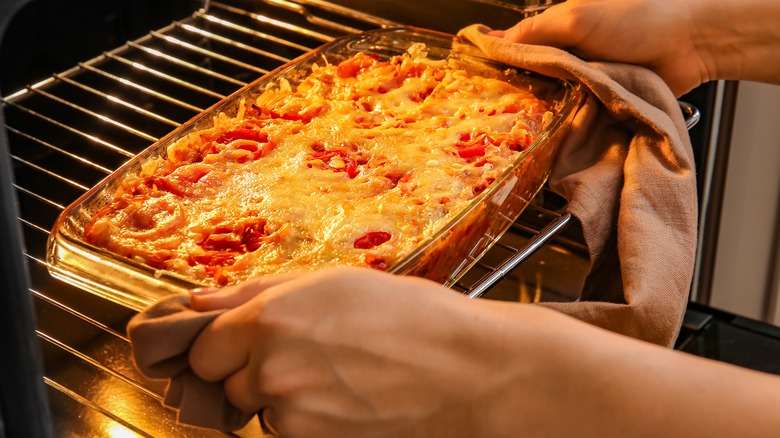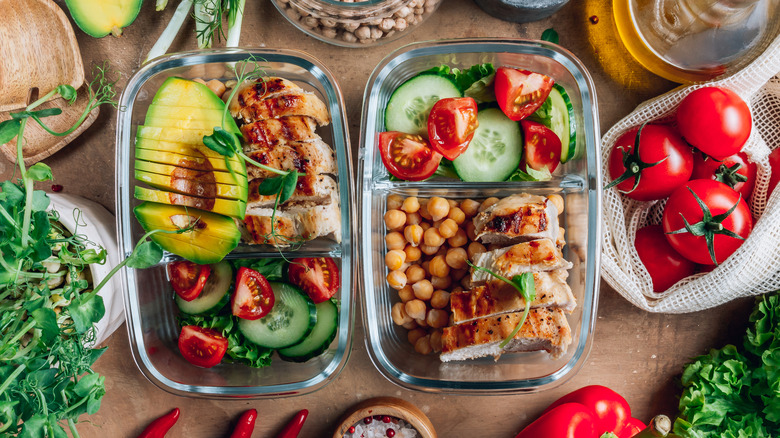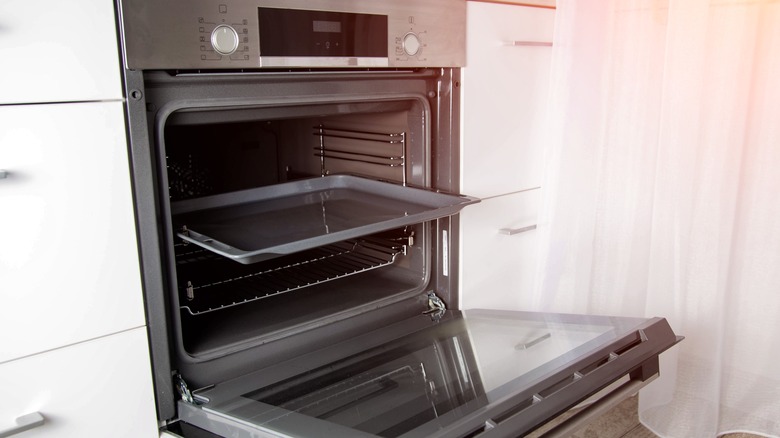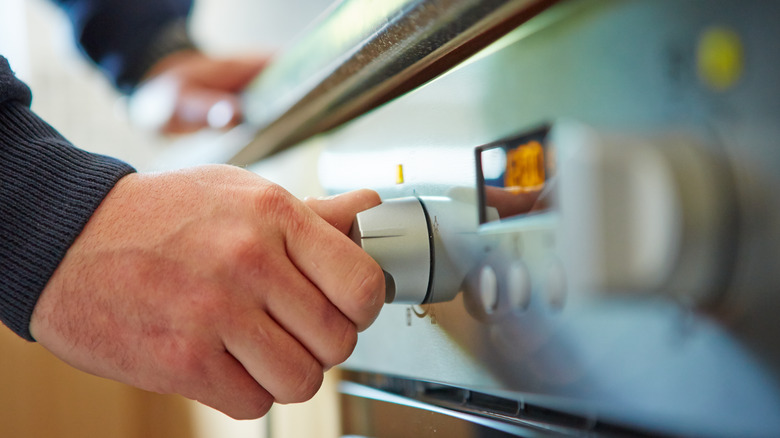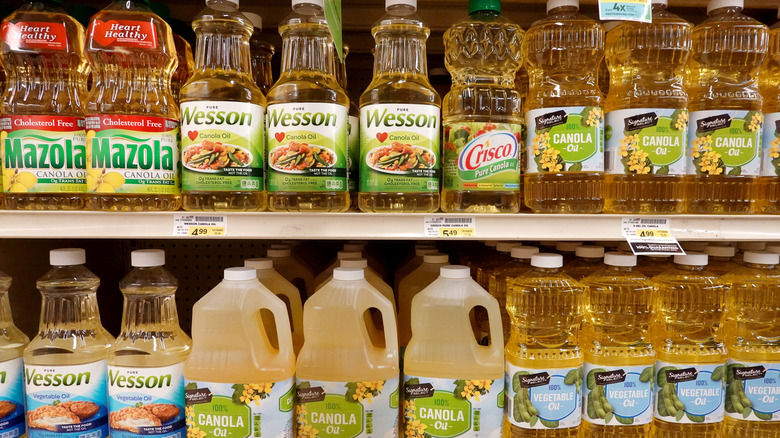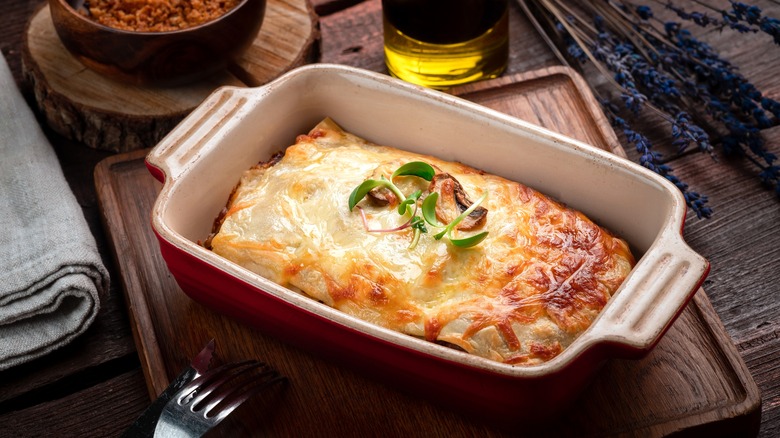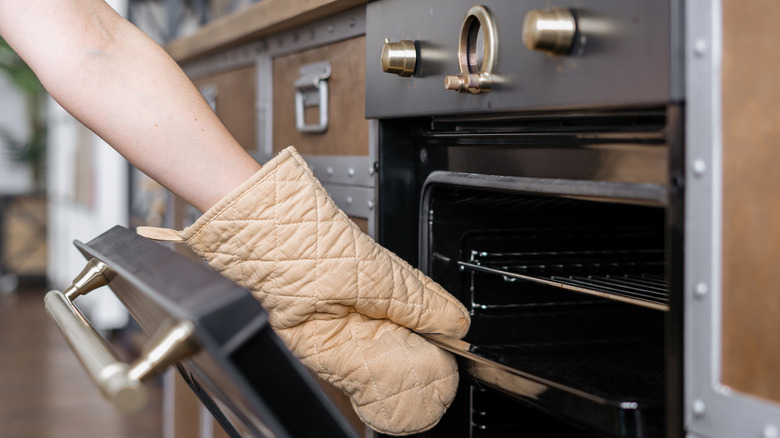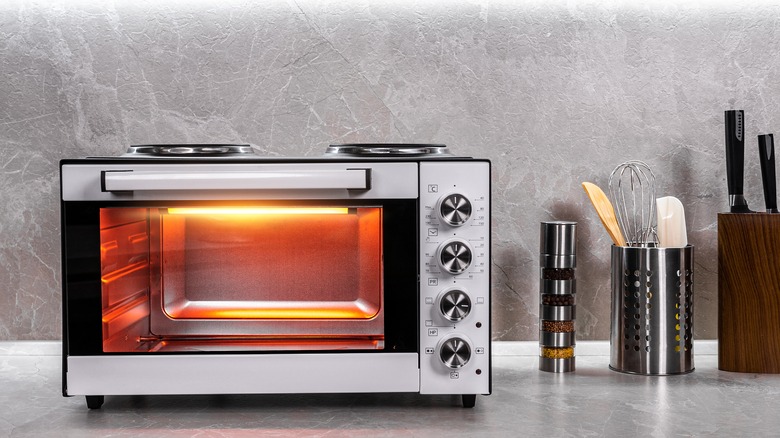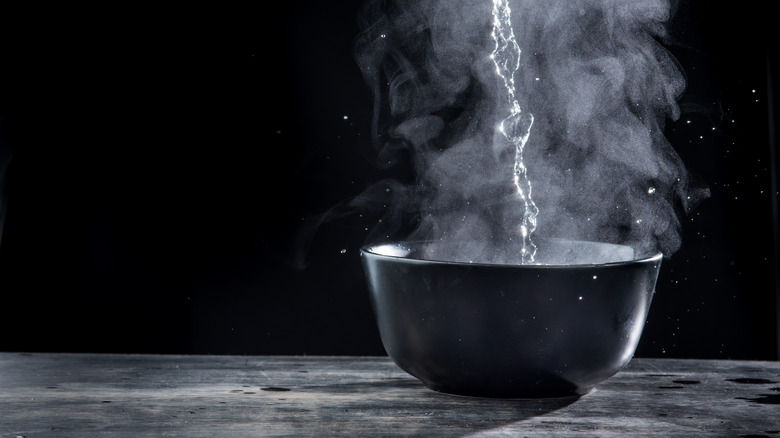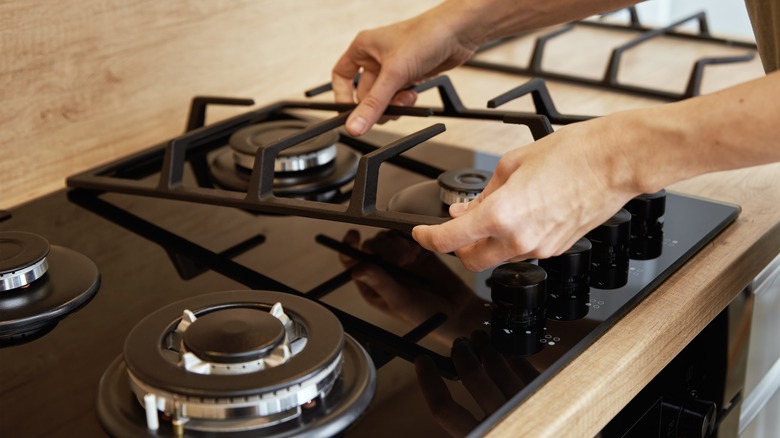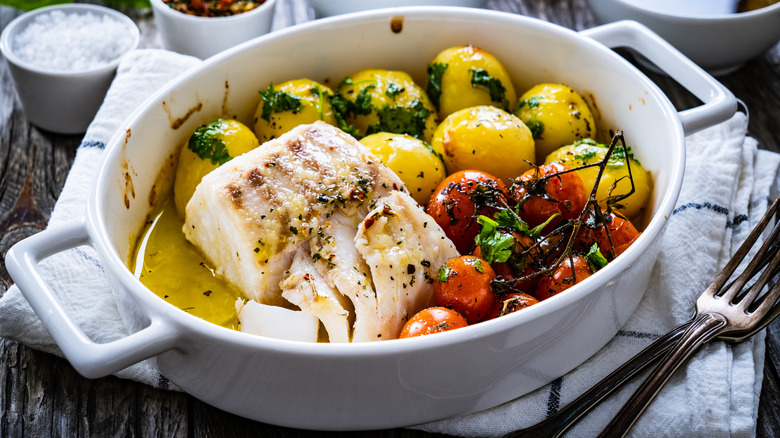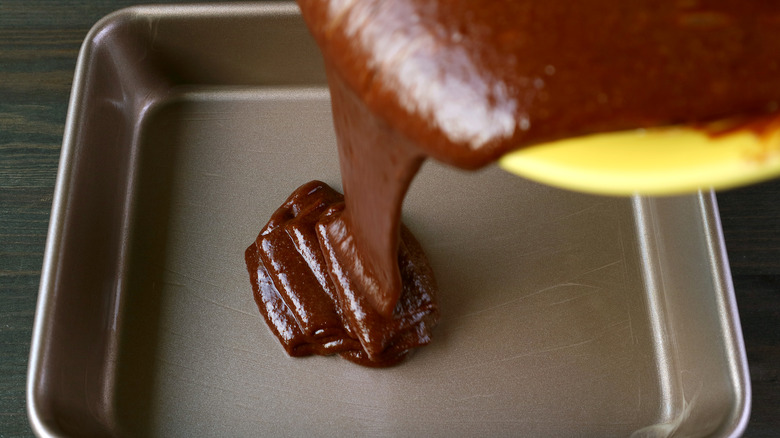11 Tips You Need When Cooking With Glassware
Nothing beats the feeling that comes from pulling a deep-dish casserole recipe or lasagna from the oven, covered with melted cheese and creamy sauce, knowing that soon you'll be taking a big bite of the noodley goodness that has your whole kitchen smelling irresistible. Oven-baked dishes are beloved for being both tasty to eat and easy to make, which is why they tend to be such staples for busy households. Assuming you're going to be making more than one casserole in your lifetime, it only stands to reason that you'll want to find an ideal pan. Yet, with so many oven-friendly options, which one to choose?
Cooking your oven-baked dishes in glassware has a lot of distinct advantages, such as easier clean-up and no lingering aftertaste from the pan, as glass is a non-reactive material unlike other dishes often used for baking. There are plenty of upsides, but glassware isn't ideal for every oven-friendly dish, and glass dishes aren't always the most intuitive cookware. Cooking with glass can easily go awry, with shattered pans and burnt meals rating high on the list of potential hazards.
However, plenty of cooks swear by glassware, and if you've got the time and the patience to learn, you might come to rely on that easy-to-clean casserole dish just as much as any other tool in your kitchen arsenal.
Opt for glassware when you need versatility
As any regular user of glassware knows, it is a versatile container as well as a solid choice for cooking certain foods. Once it cools, a glass pan is easy to cover and pop right into the refrigerator without worrying whether it'll keep or not. In fact, lots of glass dishes come with fridge-friendly covers just to make storage that much easier. Additionally, one of the main benefits of glassware is how easy it is to clean. A quick soak will soften the remaining food, and using a scrubbing pad with no concern over whether or not you'll scratch the surface will set your mind at ease during the process.
Glassware takes longer to heat as it's a poor conductor. However, this disadvantage quickly becomes an advantage when you're counting on a meal to heat slowly while wanting it to retain that temperature longer once it's out of the stove. Setting a glass dish out for serving helps your family or guests to grab a spatula and serve themselves without concern for the extra mess. Once it cools, its temperature will stay stable, meaning it's a good container for traveling.
Preheat the oven
Anytime you bake, preheating the oven is a crucial step, preventing your dish from cooking unevenly and making certain that the temperature remains the same. This goes double for glassware, which tends to take a little extra time to heat up but is able to keep consistent heat for longer. A preheated oven and glass dish are a perfect combo for cooking things like enchilada dishes to excellence. The gradual process can be magic if timed well, and preheating is going to play a major role in that.
Preheating is extra important when cooking things with strict safety guidelines like chicken, which requires being cooked at a certain temperature for a specific time. It's an implicitly practical thing to do, with the time saved by skipping this step often eaten up by the lengthier cooking time that comes from not doing it. Aviv Service Today suggests preheating at 75 degrees Fahrenheit above the cooking temperature and then lowering it to the recommended number due to the fact that your oven immediately loses some heat any time it's opened.
Moderate the time and temperature accordingly
Glass interacts much differently with heat than metal does, and with many recipes assuming that the chef will be using multipurpose metal pans to cook the dish, it's important to keep this in mind when using glassware. Making the small adjustment to cook about 10 minutes longer than you would with a metal pan can make all the difference. Giving your dish the time it needs to warm up while the glass will do its part by keeping it hot for a long time to come.
Likewise, lowering the temperature by about 25 degrees Fahrenheit is recommended by many cooks in order to avoid the browning that might come from leaving the dish in the stove for a slightly longer period of time. The surface of the dish will heat at about the same time while everything underneath has to make its way through that thick glass to cook all the way through. These adjustments can definitely improve the meal, and your taste buds will thank you.
Oil the dish every time
Depending on what you're making, you could also use materials like butter, ghee, or vegetable shortening, but the most important thing to remember is that regardless of whether the recipe calls for it, you're going to want to oil the pan before you get to baking. This prevents burnt edges as well as makes the inevitable cleaning process easier. Much like preheating, it's a crucial step when cooking anything in the oven, especially when using glassware. This goes double for any kind of cake, which will benefit from buttering the pan and then flouring it as well, and even using parchment paper on top of that to prevent sticking.
The material you use for greasing the pan can change with whatever dish you're making. For instance, if you're baking a cake, chances are you're going to want to use something flavorful like softened butter. That isn't necessarily going to work for something like enchiladas, which would likely benefit from vegetable shortening or oil. Dishes like lasagna do great with oil, while baked macaroni and cheese might have you reaching for the margarine instead. It's a subtle part of the baking process, but it can make a world of difference when it comes time to sit down at the table and eat.
Don't bake dry dishes in glassware
Due to the extra threat that uneven heat distribution can mean for glassware, it is recommended not to cook any dry dishes. The liquid is a major part of what helps distribute heat in a safe and consistent way, which is why glassware is so great for things that are mired in sauce and less good for dry ribs and that sort of thing. That said, cooking meat in glassware can be a great idea, but there are a few safety tips that can save you a lot of time and heartache in the long run.
To begin with, don't baste chicken or turkey with cold water when cooking with glassware as temperature shock is potentially quite hazardous. Similarly, rather than popping a piece of chicken in the pan and hoping it will cook evenly, adding a bit of water will help the glass maintain a consistent heat. These are especially important details to keep in mind as glassware does have the potential to shatter. More than anything, cooking with glass safely means keeping in mind its resilience but also its sensitivity to extremes.
Always use dry oven mitts
You're definitely going to want to use oven mitts when handling the pan. Sure, this sounds like common sense, but even the most by-the-book person has likely found themselves attempting to substitute a towel for a proper oven mitt at some point in their lives. You're also going to want to make sure that those gloves are bone dry before pulling that pan out of the oven.
Avoiding using damp or wet oven mitts is good all-around advice considering that non-dry oven mitts lose their protective value and can cause scalding or burns. This is not a chance you want to take, so it's for the best to make sure that your oven mitts are stored in the same easy-to-find place and are ready for use well before you even get started preheating the oven. Nothing shatters a glass pan faster than dropping it on the floor when you realize it's way too hot to handle.
Use glassware in a traditional oven only
Most of the advice geared toward glassware involves avoiding any kind of extreme heat or rapid temperature changes, which is why almost all glassware should be used in a traditional oven only. Toaster ovens are handy for so many things, from cooking pizzas to cornbread and even bacon. However, they rely on rapid heating and, as such, a metal sheet pan is usually your best bet. Glassware can become hazardous and crack under the intense heat.
Likewise, while reheating a dish in glassware is easy, you'll want to avoid doing so in a microwave oven. Cook too long, and you could run into issues. Traditional ovens are well-suited for glassware because they hold consistent heat, while smaller ovens and microwaves heat too quickly and can potentially shatter the dish. Plus, anyone who has burned their hand after reaching for a hot plate from the microwave understands why glass can have its disadvantages. Regardless, it's just not an efficient use.
Don't pour water into a hot dish
We've hinted at this before but now it's time to be direct; don't pour liquid into a hot dish. This may not end in disaster every single time, but it's always inviting disaster, and it's easy to avoid with just a little preplanning. While the dish is room temperature, it's absolutely fine to add a bit of room temperature water to the bottom in order to cook things like meat, which you wouldn't necessarily want to cook in glass without some kind of base liquid.
One of the fastest ways to shatter a glass pan is by pouring cold water into a hot pan or hot water into a cold pan, so it's important to always follow instructions and make sure you're being very careful when adding liquid to the dish. As part of our advice to avoid extremes of temperature, that only goes double when adding any kind of liquid to a glass pan. Glass needs time to adjust, and overwhelming it is always a bad move, and one that can cost you a lot of time and money if you're not careful.
Don't set glass dishes on your stove
Avoiding extremes of temperature means avoiding open flame or high heat, and that means never using oven-based glassware on an open stove as if your Pyrex pan's life depends on it — because it might. Though Dutch ovens and other glass dishes work great for a stovetop, most glassware isn't safe under direct heat, so it's best to always read the instructions that come with the dish to be absolutely sure what its intended use is.
For an oven dish, using the stovetop to cook could easily be hazardous, as well as not being a particularly effective method of cooking. Regardless of if you have an electric or gas stove — but particularly if your stove has metal eyes — this mistake could lead to the glass dish shattering. Even if the pan survives the ordeal, it just isn't worth the risk of having to replace the dish.
Place the dish on a cutting board or cooling rack
Now that you know what not to set your glassware on, where should you place a hot pan? Cooling racks are made exactly for situations like this, and they'll give your dinner ample time and airflow to even out temperature-wise. Likewise, a wooden cutting board could do the trick, and the wood won't react badly to the hot glass like a plastic cutting board might. Most of the tips used for heating apply equally to cooling, so, just because the pan is out of the oven, don't throw out what you've learned.
As with any meal, avoid diving right in without giving a little extra time to cool off. Likewise, before digging in with a room-temperature spoon, give it a minute to even out. The hardest part with glass is the extra waiting time, but it'll feel worth it when you're finally taking a bite of an exceptionally well-baked meal.
Glassware isn't the best choice for everything
No baking pan is perfect for everything, and knowing a dish's limitations is just as useful as knowing its strengths can be. For instance, if you want to whip up a nice bath of cookies, you're going to want to avoid using glassware due to the slow burn quality of the cookware. Not only does the heating up quality of glassware not do the fast-baking cookie any favors, the need to cool down quickly is likewise thwarted by glass's aforementioned propensity to retain heat. We're not saying that the perfect cookie is impossible in glassware, just that it adds a whole slew of challenges to the mix that are easier to avoid by simply using a metal baking sheet instead.
Just about any fast-cooking food where you're looking for a bit of browning is not great for glassware, but foods like cobblers, in which you'll be using highly reactive fruit that does best cooling down slowly rather than quickly, is perfect for the Pyrex pan. In most situations, it's going to be a matter of preference, but with dry dishes or anything where the temperature of the food requires rapid temperature changes, avoiding glass is just good common sense.
